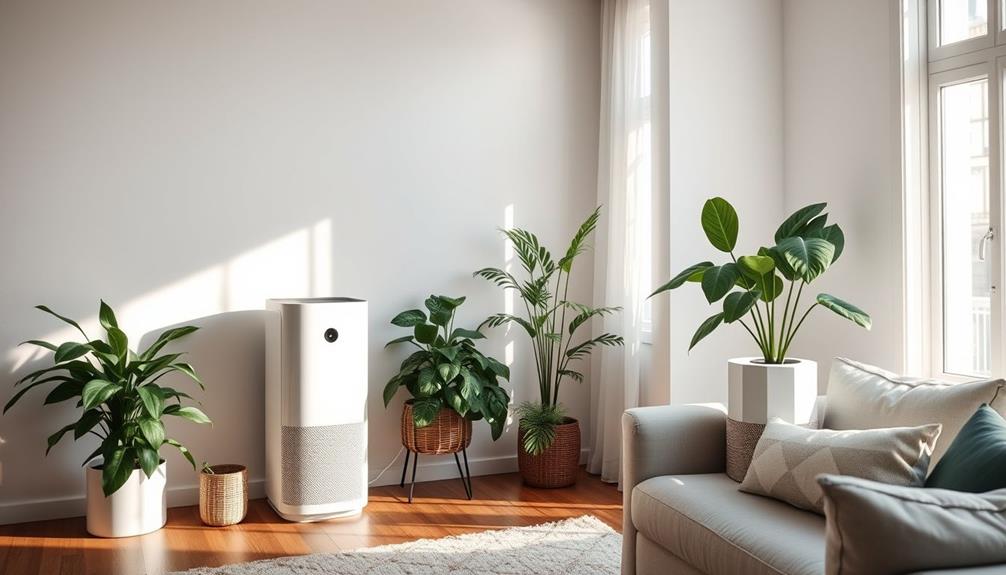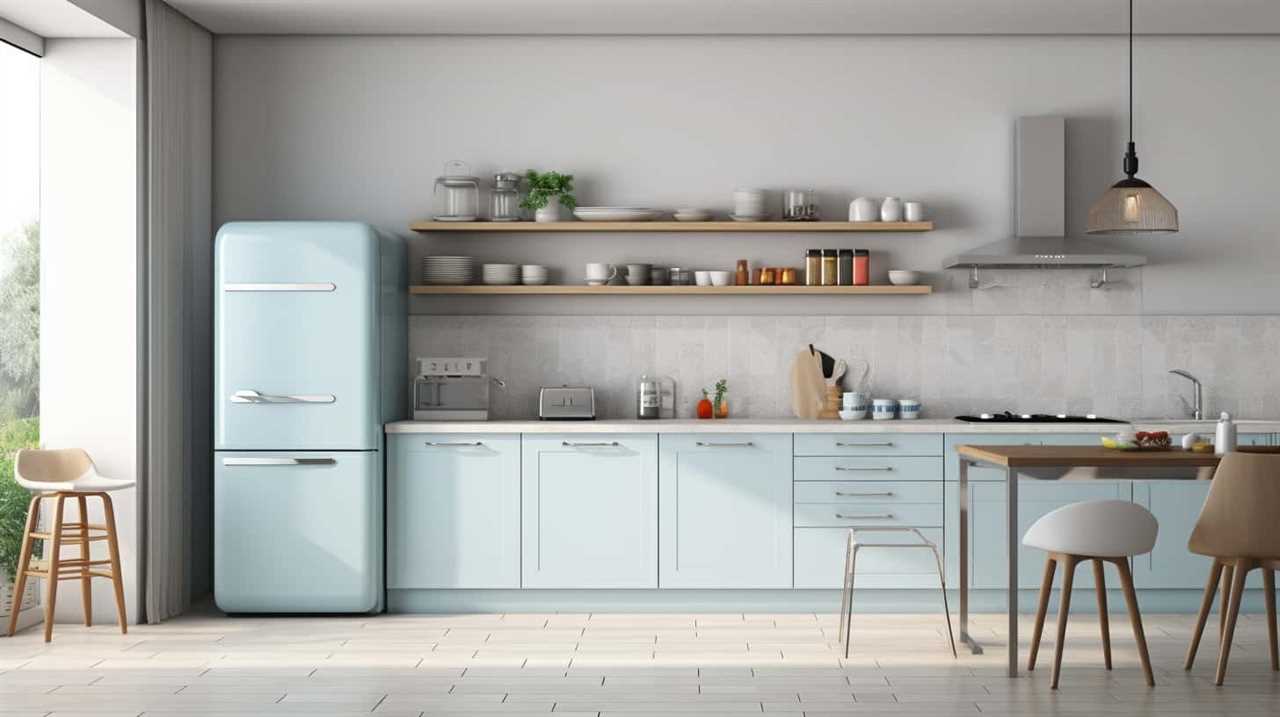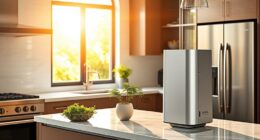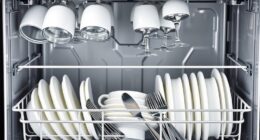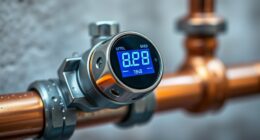To enhance the air quality inside your home, start by utilizing efficient devices such as air purifiers equipped with HEPA and activated carbon filters. These are designed to trap allergens and eliminate odors. Ensure proper air circulation by utilizing exhaust fans and opening windows to let in fresh air and remove stagnant air. Consider using dehumidifiers to maintain humidity levels at 30-50%, which helps prevent mold growth. Regular cleaning using a vacuum with a HEPA filter and eco-friendly cleaning products can also help reduce pollutants. Additionally, consider investing in energy-efficient appliances to minimize harmful emissions. By following these tips and tricks, you can significantly improve your indoor air quality and overall comfort levels.
Key Takeaways
- Use air purifiers with HEPA and activated carbon filters to effectively capture allergens and remove odors, enhancing indoor air quality.
- Maintain proper ventilation by regularly opening windows and using exhaust fans to exchange stale air with fresh outdoor air.
- Control indoor humidity levels between 30-50% to prevent mold growth and improve respiratory health, utilizing dehumidifiers when necessary.
- Establish a regular cleaning routine with a HEPA-filter vacuum and eco-friendly cleaning products to reduce indoor pollutants.
- Ensure proper maintenance of combustion appliances and consider non-combustion alternatives to minimize harmful emissions in your home.
Understanding Indoor Air Quality
Understanding indoor air quality (IAQ) is fundamental for maintaining a healthy living environment. Indoor air pollutants can greatly impact your health, often being 2-5 times higher than outdoor levels. These pollutants include dust, mold, volatile organic compounds (VOCs), and gases like carbon monoxide and radon. Vulnerable populations, such as children and those with respiratory conditions, are particularly at risk.
Implementing solutions like using ozone air purifiers can be particularly effective in neutralizing pollutants and odors in your home.
To improve your air quality, it's imperative to identify common sources of pollution in your home. Combustion appliances, household cleaning products, and even outdoor pollutants can infiltrate your indoor spaces. Proper ventilation is key to minimizing these risks. Opening windows and using exhaust fans can help circulate fresh air and reduce pollutant concentration.
Incorporating air purifiers equipped with HEPA filters can also make a considerable difference. They effectively capture airborne particles, improving IAQ.
Regularly monitoring and testing for pollutants like radon and carbon monoxide is essential, too. By taking these steps, you not only enhance your living environment but also safeguard your health and well-being.
Understanding and addressing indoor air quality is a proactive way to guarantee a safe and comfortable home.
The Role of Air Purifiers

When it comes to improving your indoor air quality, air purifiers play an important role.
They can greatly enhance your overall well-being, similar to how holistic lifestyle approaches alleviate menopause symptoms.
You can choose from various types, each designed to tackle specific concerns like allergens and odors.
Keeping up with filter maintenance is essential to guarantee you reap the full benefits for your health and comfort.
Types of Air Purifiers
How can you guarantee the air in your home is clean and healthy? Investing in the right air purifiers is a great start. These appliances come in various types, each designed to tackle different airborne contaminants.
Cats, for example, can be sensitive to certain smells, so maintaining good air quality can help reduce their stress and promote a healthier environment for them. Additionally, understanding how feline behavior can be influenced by air quality is essential for a harmonious home.
- Breathe easier without allergens weighing you down.
- Enjoy a fresh-smelling home, free of unpleasant odors.
- Protect your loved ones from harmful bacteria and viruses.
- Say goodbye to dust and pet dander that triggers your allergies.
- Create a sanctuary of pure air in your personal space.
HEPA filters are a must-have, capturing 99.97% of particles as small as 0.3 microns, including dust and pollen. If odors or harmful chemicals are a concern, activated carbon filters effectively absorb them, enhancing your indoor air quality.
For additional protection, UV light air purifiers use ultraviolet light to deactivate bacteria and viruses. Finally, ionic air purifiers charge particles, allowing them to clump together and fall from the air, reducing allergens.
Filter Maintenance Importance
Maintaining your air purifiers is essential for ensuring they operate at peak efficiency. Regular filter maintenance is key to achieving ideal performance and improving indoor air quality.
For pet owners, especially those with active breeds like Dachshunds, it's fundamental to keep indoor air clean due to potential allergens. You should change HEPA filters every 6-12 months to effectively remove up to 99.97% of airborne particles. If you don't replace these filters on time, you risk diminishing the purifier's effectiveness.
Additionally, activated carbon filters should be replaced every 3-6 months. This prevents odor recirculation and keeps your indoor environment fresh.
Don't forget to clean pre-filters monthly; this simple task enhances airflow and reduces the burden on your main filters, ultimately prolonging their lifespan.
Many air purifiers come with indicator lights that notify you when it's time for a filter replacement, making maintenance more manageable. Regularly checking your air purifiers can also help you spot any operational issues early on, ensuring consistent air purification.
Benefits for Allergies
Since allergens like pollen, pet dander, and dust mites can wreak havoc on your health, using air purifiers equipped with HEPA filters is a smart choice.
These devices capture 99.97% of airborne particles, considerably reducing allergy symptoms and improving your indoor air quality. As a result, you may experience fewer respiratory symptoms and feel more at ease in your home.
Incorporating air quality management into your overall wellness routine can complement your healthy lifestyle goals, as discussed in key components for a healthy lifestyle.
Consider these benefits of air purifiers for allergy sufferers:
- Breathe easier without the suffocating presence of allergens
- Enjoy a cleaner, fresher living space free from irritants
- Reduce the frequency and severity of allergy attacks
- Experience fewer headaches and fatigue caused by poor air quality
- Create a safe haven for your loved ones with allergies
Regularly maintained air purifiers can also help lower levels of volatile organic compounds (VOCs) and other harmful irritants.
Many models come with activated carbon filters that absorb odors and harmful gases, further enhancing your indoor air quality.
Benefits of Proper Ventilation

Proper ventilation is essential for creating a healthy indoor environment. By guaranteeing proper ventilation, you can greatly improve your indoor air quality. It facilitates the exchange of stale air with fresh outdoor air, reducing indoor pollutants like carbon monoxide and volatile organic compounds (VOCs). This is especially important in tightly sealed homes where pollutants can accumulate.
Additionally, incorporating regular HVAC maintenance can help identify potential issues that affect air quality and system efficiency. Utilizing exhaust fans in kitchens and bathrooms is a smart move; they effectively remove excess moisture and odors, preventing mold growth and promoting a healthier living space. Natural ventilation, such as opening windows on days with good air quality, can also enhance air flow and dilute indoor pollution sources.
Mechanical ventilators work hand-in-hand with your HVAC system, optimizing energy efficiency while maintaining adequate air flow. Regular maintenance of these systems guarantees they operate effectively, helping to lower the levels of indoor air contaminants that can impact your health and comfort.
Managing Indoor Humidity
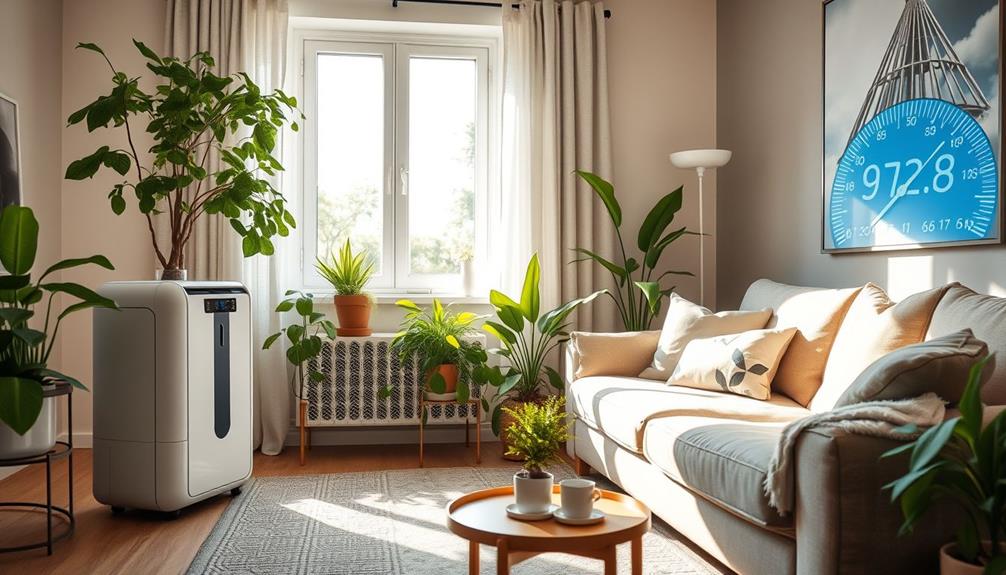
Humidity plays an essential role in your indoor air quality, so managing it effectively can make a significant difference in your home's health.
Keeping humidity levels between 30-50% is vital to prevent mold growth and support respiratory health. High humidity fosters mold and dust mites, which can lead to serious health issues.
Maintaining proper indoor conditions can also enhance the longevity of your appliances, such as high-quality home printers, which can be negatively affected by excess moisture.
To manage indoor humidity, consider these steps:
- Invest in dehumidifiers, especially in damp areas like basements and bathrooms.
- Regularly monitor humidity levels with a hygrometer.
- Use humidifiers during dry conditions to maintain comfort.
- Guarantee proper ventilation in rooms prone to moisture.
- Address any leaks or water damage promptly.
Effective Cleaning Practices
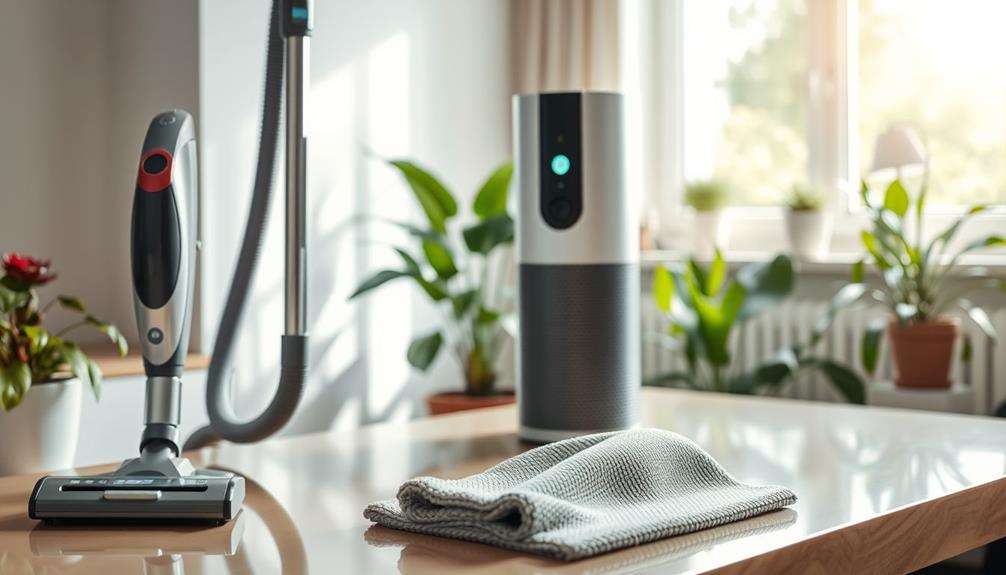
To improve your indoor air quality, establish a regular vacuuming schedule using a HEPA-filter vacuum.
Options like the BISSELL CleanView Swivel Upright offer affordability and effectiveness for maintaining cleanliness.
Choose eco-friendly cleaning products to reduce harmful chemicals in your home.
Don't forget to maintain your air purifier to guarantee it effectively captures pollutants and allergens.
Regular Vacuuming Schedule
A well-planned vacuuming routine is essential for maintaining a healthy indoor environment. Establish a regular vacuuming schedule at least once a week to efficiently remove dust, allergens, and pollutants from your carpets and rugs.
Using a vacuum cleaner equipped with a HEPA filter will notably enhance your indoor air quality by capturing 99.97% of particles as small as 0.3 microns, including dust mites and pet dander. Additionally, consider hiring a professional cleaning service to assist with deeper cleaning tasks, as they often have access to specialized equipment and trained staff for ideal results key factors in choosing a home cleaning service.
To truly improve your air filtration, consider the following tips:
- Vacuum high-traffic areas and spots where pets rest two to three times a week.
- Use a vacuum with a sealed system to prevent recirculating captured dust and allergens.
- Regularly clean or replace vacuum filters and bags for ideal performance.
- Invest in a quality vacuum that meets your needs and lifestyle.
- Create a fun schedule or routine that makes vacuuming less of a chore.
Eco-Friendly Cleaning Products
Choosing eco-friendly cleaning products can make a considerable difference in your indoor air quality. These products typically contain natural ingredients that help reduce the release of volatile organic compounds (VOCs), which are major contributors to indoor air pollution.
Unlike conventional cleaning products that often contain harmful chemicals like phthalates and parabens, eco-friendly options prioritize your health and the environment. For instance, using natural alternatives like butter, which is rich in vitamins, can contribute to a healthier home environment alongside effective cleaning practices.
By switching to eco-friendly cleaning solutions, you can considerably lower indoor air pollutants. Research shows that homes using these products can see a reduction in harmful chemicals by up to 50%.
Natural alternatives like vinegar, baking soda, and essential oils not only clean effectively but also minimize your exposure to harmful substances, promoting better indoor air quality.
Using eco-friendly products also supports sustainable practices. Many come in biodegradable packaging and are made from renewable resources, which reduces your environmental impact.
In a world where indoor air pollution can lead to respiratory issues and other health risks, making the switch to eco-friendly cleaning products is a simple yet impactful choice for you and your family.
Embrace these alternatives, and enjoy a cleaner, healthier home.
Air Purifier Maintenance
Maintaining your air purifier is key to ensuring it operates at peak efficiency and keeps your indoor air clean.
Regular maintenance helps eliminate airborne contaminants and prolongs the lifespan of your device.
Here are some effective practices to follow:
- Replace HEPA filters every 6 to 12 months to maintain ideal particle capture efficiency.
- Clean pre-filters monthly by vacuuming or washing them to enhance airflow and extend HEPA filter life.
- Wipe down the exterior and interior of the air purifier with a damp cloth to remove dust and contaminants, preventing them from re-entering your air supply.
- Keep the air purifier in an open area to avoid airflow obstruction; place it at least a few feet away from walls and furniture for ideal performance.
- Follow the manufacturer's guidelines for maintenance, as different models may have specific requirements.
Importance of Bedding Hygiene
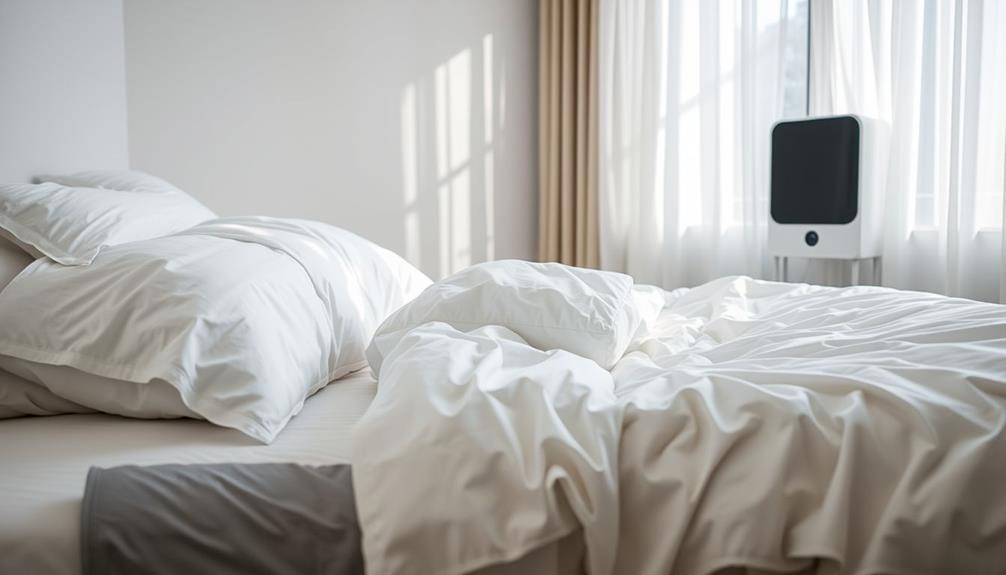
While it might seem easy to overlook, bedding hygiene plays an essential role in your overall indoor air quality and health. Regularly washing your bedding in hot water—at least 130°F—is important for eliminating dust mites and allergens that can aggravate respiratory issues. Aim to wash your sheets and pillowcases weekly to create a hygienic sleeping environment and reduce your exposure to indoor pollutants.
Using allergen-proof covers on pillows and mattresses can further decrease the amount of dust mite allergens, leading to better sleep quality.
Don't forget about vacuuming your bedding frequently with a vacuum cleaner equipped with a HEPA filter. This can effectively remove accumulated dust and allergens that negatively impact indoor air quality.
Maintaining a clean and allergen-free bedroom is essential. Studies show that poor bedding hygiene is linked to increased symptoms of asthma and allergies.
Combustion Appliances and Risks

When you use combustion appliances like gas stoves and heaters, you're exposing your home to harmful pollutants that can seriously impact your health.
This is especially concerning for vulnerable groups, such as children and those with existing respiratory conditions.
To protect yourself and your loved ones, it's essential to guarantee proper ventilation and consider cleaner alternatives whenever possible.
Emission of Harmful Pollutants
Many homes rely on combustion appliances like gas stoves, furnaces, and water heaters, which can release harmful pollutants such as nitrogen dioxide (NO2) and carbon monoxide (CO).
These emissions contribute to indoor air pollution and can exacerbate respiratory issues, decreasing lung function over time. Inadequate ventilation while using these appliances increases the risk of health complications, making it essential to address this issue.
Consider the following emotional impacts of indoor air pollution:
- Breathing difficulties that can hinder daily activities
- Chronic health conditions that may disrupt family life
- Increased healthcare costs from ongoing medical treatments
- Loss of quality time with loved ones due to illness
- The worry of long-term effects on children's health
The American Lung Association recommends changing to non-combustion alternatives like electric heat pumps and induction cooktops to greatly reduce health risks associated with combustion appliances.
Regular maintenance and proper ventilation can also help mitigate harmful pollutant emissions. By taking these steps, you can improve your indoor air quality and create a healthier home environment for you and your family.
Vulnerable Populations at Risk
Combustion appliances pose considerable risks to vulnerable populations, including children, pregnant individuals, and those with pre-existing lung conditions. These groups face heightened health risks from indoor air pollution caused by emissions such as nitrogen dioxide and carbon monoxide. Long-term exposure to these pollutants can lead to severe health issues like heart disease, stroke, asthma, and respiratory diseases, particularly impacting those already sensitive to them.
Research shows that indoor air pollution levels from fuel-burning appliances can be 2-5 times higher than outdoor pollution, further exacerbating risks for vulnerable populations. While proper ventilation and maintenance of combustion appliances can help reduce exposure, many homes lack adequate ventilation, leaving susceptible individuals at greater risk.
To protect these populations from harmful indoor air pollutants, it's essential to contemplate shifting to non-combustion alternatives. The American Lung Association advocates for solutions like electric heat pumps, which can greatly improve indoor air quality without the associated health risks of combustion appliances.
Importance of Proper Ventilation
Indoor air quality can greatly impact health, especially for vulnerable populations. Proper ventilation is essential when you're using combustion appliances like gas stoves or heaters. These appliances can emit dangerous air pollutants like nitrogen dioxide and carbon monoxide, which substantially degrade indoor air quality.
To protect your health and that of your loved ones, consider these points:
- Asthma attacks may worsen
- Long-term diseases can develop
- Children and pregnant women are at higher risk
- Carbon monoxide poisoning is a real danger
- Poor air quality affects everyone's well-being
Maintaining a well-ventilated space helps dilute and reduce these harmful pollutants. Using range hoods that vent outside during cooking and ensuring proper ventilation when using gas appliances can mitigate the risks associated with indoor combustion.
Don't overlook regular maintenance and inspection of your combustion appliances—this is key to minimizing indoor air pollution. By prioritizing proper ventilation, you safeguard your environment and greatly reduce potential health issues for you and your family.
Take action today to create a healthier living space!
Utilizing Indoor Plants

A diverse array of indoor plants can remarkably enhance your home's air quality while adding a touch of nature to your space. Plants like peace lilies, spider plants, and ferns act as natural air filters, absorbing harmful pollutants such as formaldehyde and benzene. Research shows that certain indoor plants can remove up to 87% of indoor air toxins in just 24 hours, considerably helping to improve your indoor air.
In addition to filtering out toxins, indoor plants increase humidity levels, which can reduce the likelihood of respiratory issues and combat dryness. This is particularly important in areas prone to mold and mildew, where maintaining moisture balance is vital.
By incorporating a variety of indoor plants, you can target different airborne contaminants, maximizing overall air quality.
To reap these benefits, regular care and maintenance are key. Make sure your plants receive proper watering and adequate light exposure to thrive.
With the right selection and care, indoor plants can transform your home into a healthier environment, providing you with clean air and a natural aesthetic that brightens your living space.
Energy-Efficient Appliance Choices
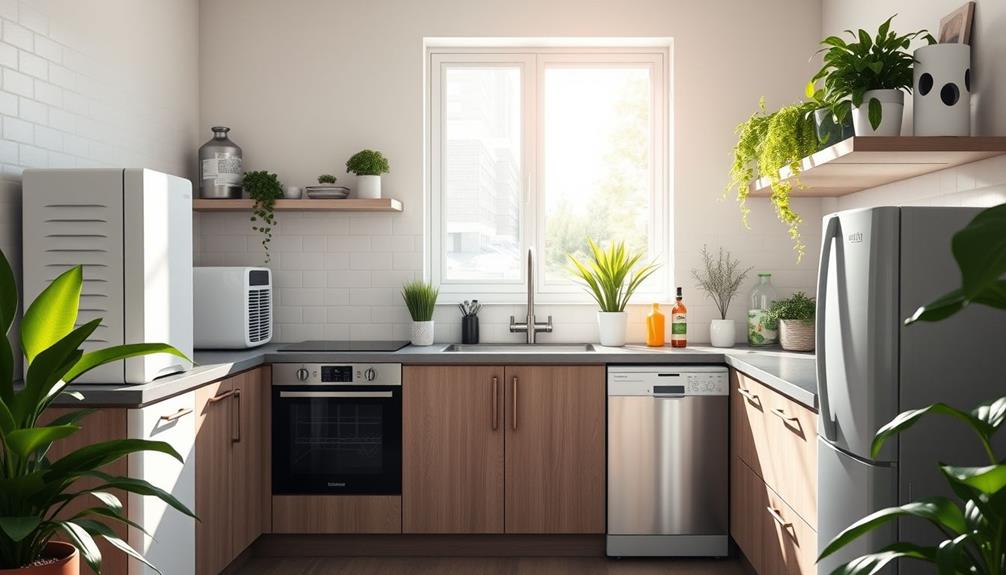
When it comes to improving air quality, energy-efficient appliances can make a significant difference. By choosing ENERGY STAR-rated models, you can cut energy use by up to 50%, which helps reduce indoor air pollution from harmful combustion emissions.
Electric heat pumps replace traditional gas heating systems, providing efficient heating and cooling while eliminating harmful emissions indoors.
Consider upgrading to energy-efficient cooking appliances like induction cooktops—they heat food directly without burning fuel, reducing the release of harmful pollutants. Smart appliances can also enhance energy consumption by adjusting their operation based on real-time air quality data, further improving your environment.
Here are some compelling reasons to switch to energy-efficient appliances:
- Breathe easier with reduced indoor air pollution.
- Enjoy a healthier home for your family.
- Save money on energy bills while protecting the planet.
- Prevent mold growth with efficient dehumidifiers that maintain ideal humidity levels.
- Feel good knowing you're contributing to a cleaner environment.
Investing in these appliances not only helps improve air quality but also leads to a safer, more comfortable living space.
Regular Maintenance for IAQ

Maintaining your home's appliances and systems is essential for ensuring ideal indoor air quality (IAQ). One of the most important tasks is regularly changing your HVAC filters. You should aim to replace them every 1-3 months, depending on usage and filter type, to keep dust and allergens from recirculating in your home.
Additionally, scheduling annual professional inspections for your HVAC system can help pinpoint potential issues that might affect your indoor air quality.
Don't forget about your air purifiers and dehumidifiers; follow manufacturer recommendations for filter changes and cleaning to guarantee they function effectively.
Cleaning your air ducts every 3-5 years is also critical to remove accumulated dust, mold, and other contaminants.
Proper ventilation is key to maintaining good IAQ. Regularly check and clean your exhaust fans in kitchens and bathrooms to enhance airflow and control humidity levels, which helps prevent mold growth.
Frequently Asked Questions
What Is the Most Effective Way to Improve Indoor Air Quality?
To improve indoor air quality, focus on using HEPA air purifiers, regularly replacing HVAC filters, and maintaining proper humidity levels. Ventilation and carbon monoxide alarms also enhance safety while promoting a healthier living environment.
What Appliances Cause Indoor Air Pollution?
Ever wonder what appliances might be harming your indoor air? Gas stoves, unvented furnaces, and older models can emit harmful pollutants. Household products, like cleaners and paints, also contribute to poor air quality you should avoid.
What Materials Improve Indoor Air Quality?
To improve indoor air quality, consider using HEPA filters, activated carbon, and UV-C light technology. Whole-home dehumidifiers and ionic air purifiers also help reduce pollutants, ensuring you breathe cleaner, fresher air every day.
What Appliance Increases Humidity Levels?
To increase humidity levels, you can use a humidifier, which adds moisture to the air. Additionally, cooking on a gas stove, taking hot showers, or drying clothes indoors can also effectively boost indoor humidity.
Conclusion
Improving your indoor air quality is like nurturing a garden; it thrives with the right care. By choosing the right appliances, ventilating properly, and keeping humidity in check, you can create a revitalizing oasis in your home. Don't forget about those green companions—plants that purify the air! With regular maintenance and mindful choices, you're not just breathing easier; you're cultivating a healthier, happier space for you and your loved ones. Breathe deep and enjoy the fresh air!
